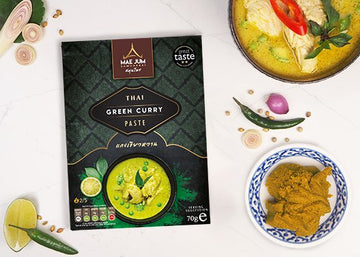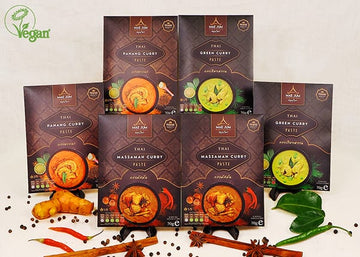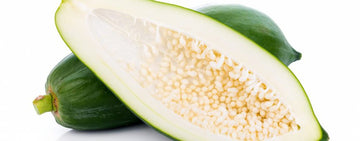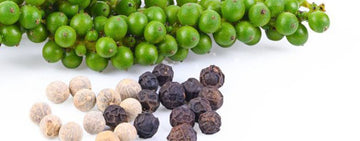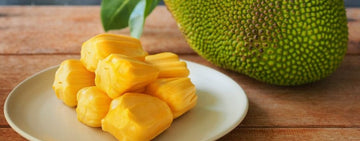Essential Thai Herbs and Spices: The Heart of Authentic Thai Cuisine
When it comes to Thai cooking, one thing stands out above all else—the harmonious balance of flavours. Thai cuisine is famous for its unique combination of the four essential taste pillars: salty, sweet, sour, and spicy. Achieving this balance relies heavily on the use of fresh herbs and spices, each carefully chosen to create the depth and complexity that characterise Thai dishes. Without these ingredients, many Thai recipes simply wouldn’t have the same bold flavours and fragrant aromas that make the cuisine so beloved around the world.
In this blog, we’ll explore the essential Thai herbs and spices you need to know, how they are used, and why they’re so important in Thai cooking. We’ll also take a look at the crucial role of Thai curry pastes, which form the foundation for many iconic dishes.
The Importance of Thai Pastes
For many Thai recipes, it all starts with a paste. Whether it’s a spicy curry or a fragrant stir-fry, Thai pastes are the key to building layers of flavour. While it may be tempting to grab a ready-made paste from the supermarket, it’s important to understand that not all pastes are created equal. Mass-produced pastes often lack the freshness, heat, and complexity that come from using whole spices, fresh herbs, and traditional preparation methods.
Authentic Thai pastes, like those from Mae Jum or homemade versions, are made using whole spices and a blend of dried and fresh herbs. Traditionally, these ingredients are pounded together in a pestle and mortar, a method that extracts maximum flavour and creates a rich, smooth texture. Although this process requires time and effort, the results are well worth it. The flavours you achieve by making your own paste are far more vibrant and aromatic compared to pre-made options.
If you’re new to making Thai pastes, here’s a handy tip: start by pounding the dry spices first, breaking them down into smaller pieces before adding fresh herbs. The moisture from the herbs will help everything come together into a smooth paste.

Essential Thai Herbs and Spices
So, what are the key herbs and spices that make up the backbone of Thai cuisine? From fiery chillies to fragrant lemongrass, here are some of the most important ingredients you’ll need to master Thai cooking.
1. Chillies, Garlic, and Shallots
At the heart of nearly every Thai paste are three fundamental ingredients: chillies, garlic, and shallots. These aromatic staples are the building blocks of Thai cuisine, providing heat, depth, and richness to a variety of dishes.
- Chillies: Thai cooking uses both red and green chillies, with different varieties offering varying levels of heat. Red chillies tend to be spicier, while green chillies are often used for their fresh, grassy flavour. Whether you prefer a mild spice or something that will blow your taste buds away, chillies are a must-have ingredient in Thai cooking.
- Garlic: With its pungent, savoury flavour, garlic adds depth to Thai pastes and sauces. Fresh garlic is always preferable, as it provides a stronger and more aromatic flavour than pre-chopped or dried versions.
- Shallots: Smaller and sweeter than onions, shallots bring a mild, slightly sweet flavour to Thai pastes, balancing the heat from the chillies and the sharpness of the garlic.
These ingredients serve as the base for many Thai pastes, and once you’ve got them, you’re well on your way to creating a variety of traditional dishes.
2. Lemongrass, Galangal, and Turmeric
Moving beyond the base ingredients, lemongrass, galangal, and turmeric are three of the most distinctive herbs in Thai cooking. These ingredients contribute to the fragrant and complex flavours that set Thai food apart.
- Lemongrass: Lemongrass is a tall, slender herb that offers a fresh, citrusy flavour with hints of lemon and ginger. In Thai cooking, lemongrass is often chopped and bruised to release its oils before being added to curries, soups, and stir-fries. The herb’s refreshing taste is especially prominent in dishes like Tom Yum (hot and sour soup) and Tom Kha Gai (coconut chicken soup).
- Galangal: A close relative of ginger, galangal has a sharper, more peppery flavour. While ginger is commonly used in Western cooking, galangal is favoured in Thailand for its earthy, spicy notes. It can be tricky to find fresh galangal in mainstream shops, but it’s worth the search. If you want your Thai dishes to taste truly authentic, galangal is a must.
- Turmeric: Known for its vibrant yellow colour and warm, slightly bitter flavour, turmeric is an essential ingredient in many Thai curries, particularly Thai yellow curry and Southern sour curry. Fresh turmeric is used to add a beautiful golden hue and depth of flavour to these dishes. In addition to its culinary uses, turmeric is also celebrated for its anti-inflammatory properties.
These three herbs not only provide distinctive flavours but also contribute to the aromatic complexity that makes Thai food so delicious.

3. Kaffir Lime Leaves and Rind
Kaffir lime leaves are another essential herb in Thai cooking, prized for their bright, citrusy fragrance. The leaves are often torn or sliced before being added to soups, curries, and stir-fries, where they release their aromatic oils. The rind of the kaffir lime can also be used in pastes to add a zesty note.
Kaffir lime leaves are commonly used in dishes like Green Curry and Panang Curry, where their distinctive flavour enhances the richness of the coconut milk and the heat of the spices. If you can’t find fresh kaffir lime leaves, dried or frozen leaves are a good substitute, although fresh is always best for maximum flavour.
4. Fresh Coriander Roots
While coriander leaves are often used as a garnish, it’s the coriander roots that play a crucial role in Thai pastes. The roots have a more intense flavour than the leaves, with earthy, slightly citrusy notes that add depth to pastes and marinades. Coriander roots are often blended with garlic, chillies, and other spices to create the base for many Thai dishes.
5. Green Peppercorns
Green peppercorns are young, unripe pepper berries that are used in Thai cooking to add a mild heat and fresh, zesty flavour. They are often found in brine and are a key ingredient in dishes like Thai Jungle Curry, where their subtle spice complements the fiery chillies and aromatic herbs.
6. Dried Spices: Coriander Seeds, Cumin, Star Anise, and More
In addition to fresh herbs, Thai cooking also relies on a range of dried spices to build flavour. Some of the most commonly used spices include:
- Coriander Seeds: With their warm, citrusy flavour, coriander seeds are often ground and added to pastes or used whole in soups and curries.
- Cumin Seeds: Cumin brings a deep, earthy flavour to Thai dishes, particularly in red and yellow curries.
- Star Anise: Star anise has a sweet, liquorice-like flavour and is often used in Thai stews and braises.
- Cinnamon and Cloves: These warm spices are frequently used in Massaman Curry, where they add a sweet, aromatic note that balances the richness of the coconut milk and the heat of the spices.

How to Use Thai Herbs and Spices
Now that we’ve covered the essential herbs and spices, how do you use them in your cooking? Whether you’re making a traditional Thai curry or experimenting with fusion dishes, understanding how these ingredients work together is key to achieving authentic flavours.
- Curries: Thai curries, such as Green Curry, Red Curry, and Yellow Curry, all start with a base of aromatic herbs and spices. Fresh ingredients like chillies, garlic, lemongrass, and galangal are pounded into a paste, which is then cooked with coconut milk and a combination of dried spices. The result is a rich, flavourful curry that perfectly balances the 4S flavours.
- Stir-fries: Stir-fries are quick and easy dishes that rely on the bold flavours of Thai herbs and spices. Lemongrass, garlic, and chillies are often used to flavour oils, while fresh herbs like coriander and kaffir lime leaves add a burst of freshness at the end.
- Soups: Thai soups, such as Tom Yum and Tom Kha, are known for their bold, zesty flavours. These soups often start with a broth infused with lemongrass, galangal, and kaffir lime leaves, to which other ingredients like mushrooms, prawns, or chicken are added.
Conclusion: Mastering Thai Flavours with Essential Herbs and Spices
Thai cuisine is a rich tapestry of flavours, textures, and aromas, and at the heart of it all are the herbs and spices that bring the dishes to life. From the fiery heat of chillies to the citrusy zing of lemongrass, each ingredient plays a crucial role in achieving the balance of salty, sweet, sour, and spicy that defines Thai food.
Whether you’re making your own Thai pastes from scratch or experimenting with new dishes, understanding the essential herbs and spices of Thai cooking will help you create authentic and delicious meals that capture the true essence of this vibrant cuisine. So, next time you’re in the kitchen, don’t be afraid to reach for that galangal or pound some fresh chillies—you’ll be rewarded with flavours that transport you straight to the heart of Thailand.
If you enjoyed reading our Essential Thai Herbs and Spices blog post, please give this post a rating and subscribe for new blog updates and recipes. Follow and tag us @maejumsamunprai on social media for great foodie content and giveaway competitions! Read more on our blogs today!
